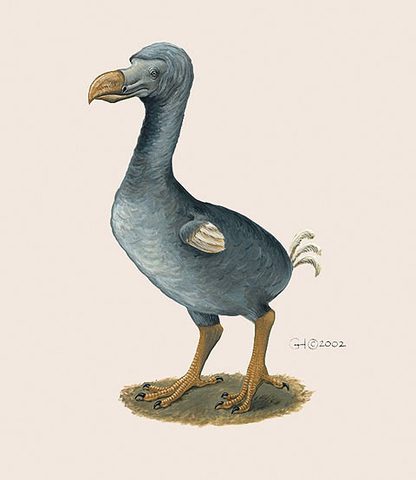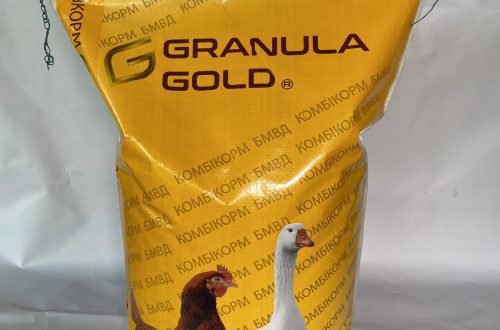
បក្សី Dodo: រូបរាង អាហាររូបត្ថម្ភ ការបន្តពូជ និងសម្ភារៈនៅសល់
The dodo is a flightless extinct bird that lived on the island of Mauritius. The first mention of this bird arose thanks to sailors from Holland who visited the island at the end of the XNUMXth century. More detailed data on the bird were obtained in the XNUMXth century. Some naturalists have long considered the dodo a mythical creature, but later it turned out that this bird really existed.
មាតិកា
រូបរាង
The dodo, known as the dodo bird, was quite large. Adult individuals reached a weight of 20–25 kg, and their height was approximately 1 m.
លក្ខណៈផ្សេងទៀត៖
- swollen body and small wings, indicating the impossibility of flight;
- strong short legs;
- paws with 4 fingers;
- short tail of several feathers.
These birds were slow and moved on the ground. Outwardly, the feathered one somewhat resembled a turkey, but there was no crest on its head.
The main characteristic is the hooked beak and the absence of plumage near the eyes. For some time, scientists believed that dodos are relatives of albatrosses due to the similarity of their beaks, but this opinion has not been confirmed. Other zoologists have spoken of belonging to birds of prey, including vultures, which also have no feathered skin on their heads.
វាគួរឱ្យកត់សម្គាល់ Mauritius dodo beak length is approximately 20 cm, and its end is curved down. The body color is fawn or ash gray. The feathers on the thighs are black, while those on the chest and wings are whitish. In fact, the wings were only their beginnings.
Reproduction and nutrition
According to modern scientists, dodos created nests from palm branches and leaves, as well as earth, after which one large egg was laid here. Incubation for 7 weeks the male and female alternated. This process, together with feeding the chick, lasted several months.
In such a crucial period, dodos did not let anyone near the nest. It is worth noting that other birds were driven away by a dodo of the same sex. For example, if another female approached the nest, then the male sitting on the nest began to flap its wings and make loud sounds, calling on its female.
The dodo diet was based on mature palm fruits, leaves and buds. Scientists were able to prove just such a type of nutrition from the stones found in the stomach of birds. These pebbles performed the function of grinding food.
Remains of the species and evidence of its existence
On the territory of Mauritius, where the dodo lived, there were no large mammals and predators, which is why the bird became trusting and very peaceful. When people began to arrive on the islands, they exterminated the dodos. In addition, pigs, goats and dogs were brought here. These mammals ate bushes where dodo nests were located, crushed their eggs, and destroyed nestlings and adult birds.
After the final extermination, it was difficult for scientists to prove that the dodo really existed. One of the specialists managed to find several massive bones on the islands. A little later, large-scale excavations were carried out in the same place. The last study was conducted in 2006. It was then that paleontologists from Holland found in Mauritius skeleton remains:
- beak;
- wings;
- paws;
- ឆ្អឹងខ្នង;
- element of the femur.
In general, the skeleton of a bird is considered a very valuable scientific find, but finding its parts is much easier than a surviving egg. To this day, it has survived only in one copy. Its value exceeds the value of a Madagascar epiornis egg, that is, the largest bird that existed in ancient times.
Interesting bird facts
- The image of the dodo flaunts on the coat of arms of Mauritius.
- According to one of the legends, a couple of birds were taken to France from Reunion Island, which cried when they were immersed on the ship.
- There are two written memos created in the XNUMXth century, which describe in detail the appearance of the dodo. These texts mention a huge cone-shaped beak. It was he who acted as the main defense of the bird, which could not avoid a collision with enemies, because it could not fly. The bird’s eyes were very large. They were often compared to large gooseberries or diamonds.
- Before the start of the mating season, dodos lived alone. After mating, the birds became ideal parents, because they made every effort to protect their offspring.
- Scientists from the University of Oxford are now conducting a series of experiments related to the genetic reconstruction of the dodo.
- At the beginning of the XNUMXst century, the sequence of genes was analyzed, thanks to which it became known that the modern maned pigeon is one of the closest relatives of the dodo.
- There is an opinion that initially these birds could fly. There were no predators or people in the territory where they lived, so there was no need to rise into the air. Accordingly, over time, the tail was transformed into a small crest, and the wings were deformed. It is worth noting that this opinion has not been scientifically confirmed.
- There are two types of birds: Mauritius and Rodrigues. The first species was destroyed in the second half of the XNUMXth century, and the second survived only until the beginning of the XNUMXth century.
- The dodo got its second name because of the sailors who considered the bird stupid. It translates from Portuguese as dodo.
- A complete set of bones was kept in the Oxford Museum. Unfortunately, this skeleton was destroyed by fire in 1755.
យន្តហោះ is of great interest by scientists from all over the world. This explains the numerous excavations and studies that are carried out today in the territory of Mauritius. Moreover, some experts are interested in restoring the species through genetic engineering.





